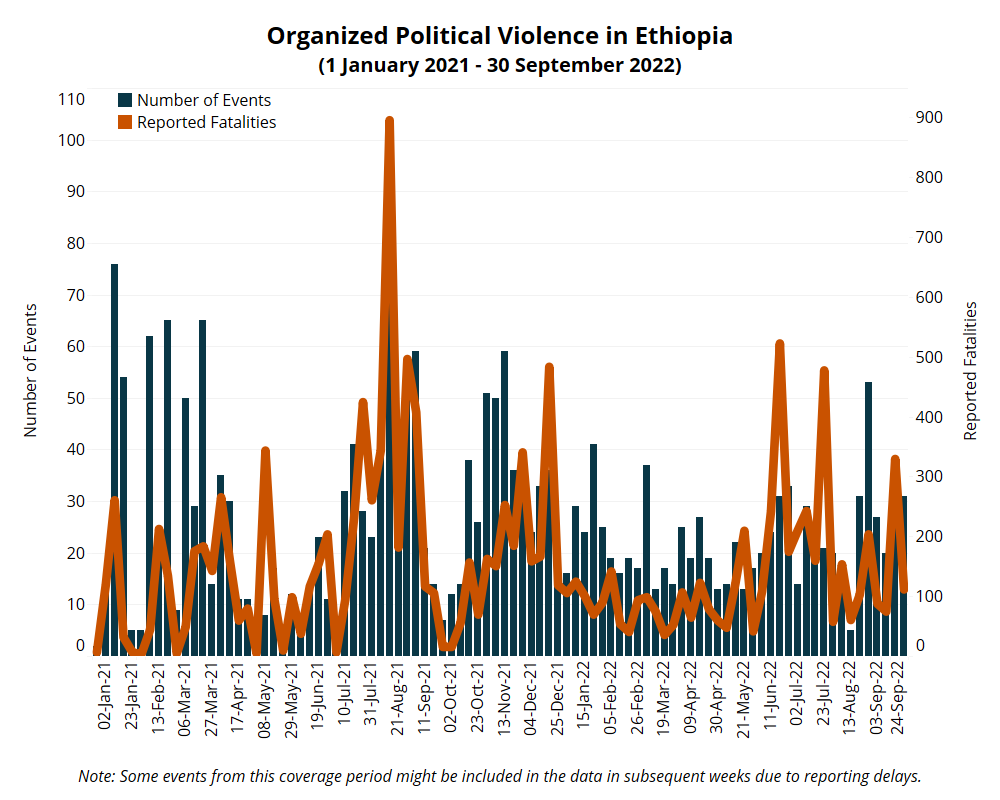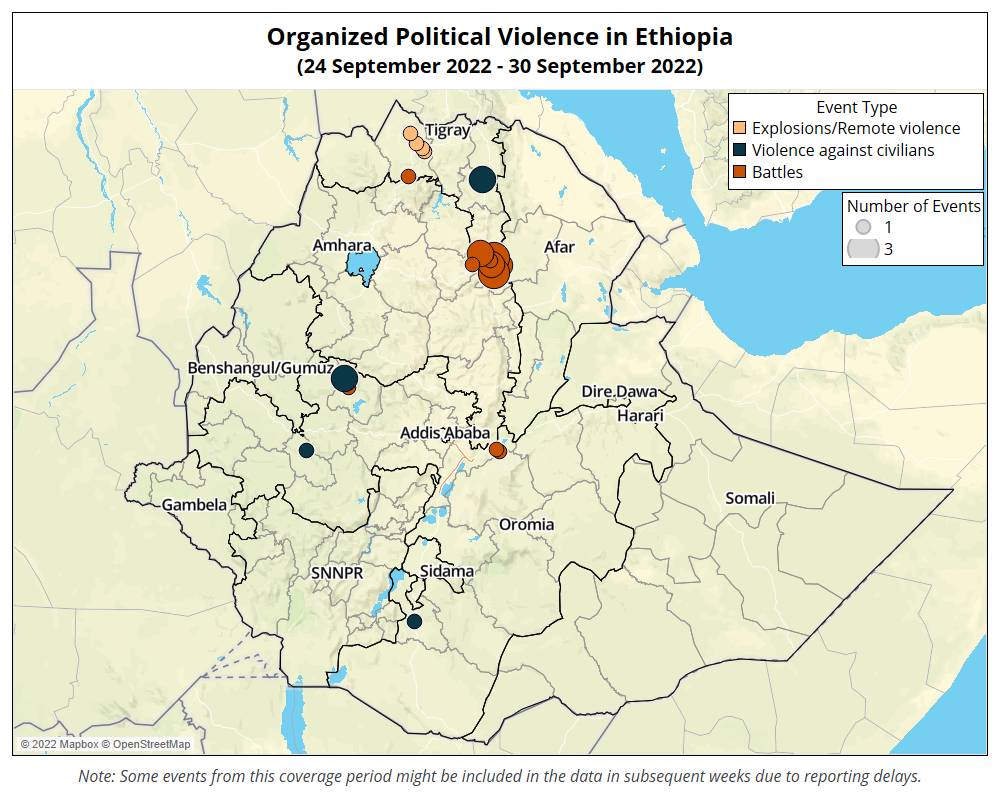By the Numbers: Ethiopia, 2 April 2018-30 September 20221Figures reflect violent events reported since Prime Minister Abiy Ahmed came to power on 2 April 2018.
- Total number of organized violence events: 3,417
- Total number of reported fatalities from organized violence: 19,701
- Total number of reported fatalities from civilian targeting: 8,591
By the Numbers: Ethiopia, 24-30 September 20222Some events from this coverage period might be included in the data in subsequent weeks due to reporting delays.
- Total number of organized violence events: 31
- Total number of reported fatalities from organized violence: 112
- Total number of reported fatalities from civilian targeting: 65
Ethiopia data are available through a curated EPO data file as well as the main ACLED export tool.

Situation Summary
Instability persisted in Oromia region and northern Ethiopia as many people were affected by the ongoing armed clashes and attacks on civilians in both areas.
In northern Ethiopia, armed clashes and drone strikes continued. Last week, at least 16 armed clash events between Tigray People’s Liberation Front (TPLF) and government forces were recorded in Raya Kobo, Gidan, and Gobiye areas in North Wello zone in Amhara region (see map below). Government forces reportedly regained control of Tekulesh, Shewi Mariam, Arefa Gorgis, Tef Weha, and Bekalimo Agola areas in Raya Kobo woreda. In Tigray region, most reported battle events occurred in North Western Tigray zone. The two parties clashed in May Tsemre area in North Western Tigray zone. Three drone strikes were also reported in Bahara, Adi Daero, and Shire in the same zone. On 25 September, the Ethiopian National Defense Force (ENDF) conducted a drone attack in Bahara. Due to this attack, a World Food Program (WFP) vehicle traveling from Shire to Zana area was damaged and its driver was injured. The government stated that the drone strikes targeted TPLF’s military camps and weapon warehouses, and asked aid workers to stop operating in these areas. The government also reiterated its accusation that the TPLF uses humanitarian vehicles to transport its forces (FDRE Government Communication Service, 26 September 2022).

Two days later, on 27 September, the ENDF conducted another drone strike in Adi Daero. At least five civilians were killed and 16 others were injured as a result of the strike. The TPLF claimed the airstrike was conducted by the Eritrean Defence Forces (EDF) using a MiG-29 fighter aircraft (Twitter @TigrayEAO, 29 September 2022). The Ethiopian government stated that its air force conducted a drone attack “targeting the locations of military equipment and arsenals of the TPLF” and said “Ethiopian National Defense Forces ensure that military assets are isolated from civilians before taking action.” The government claimed that “the airspace of Ethiopia has been under strict surveillance,” suggesting it wished to distance itself from accusations that the EDF conducted the airstrike in Adi Daero (Ethiopia Current Issues Fact Check, 30 September 2022).
In Oromia region, two armed clash events were reported in Boset woreda in East Shewa zone. The Oromo Liberation Front (OLF)-Shane and government forces clashed around Layegnaw Awash Tefases Ersha Limat (Nura Hera Ersah Limat – Nura Hera Agriculture Center) area in Boset woreda, after OLF-Shane forces reportedly began attacking civilians in the area. An unidentified number of civilians were forced to flee and the OLF-Shane was reported to have regained control of 11 camps in the agriculture center.
Attacks on civilians also continued in the region. Last week, two extrajudicial killings by government forces were reported in Buno Bedele and West Guji zones. Government forces arrested more than 1,000 people in seven woredas of West Guji zone. The arrestees were accused of supporting the OLF-Shane “logistically” by “sending their children to become members of the OLF-Shane” and having links with the OLF-Shane (ESAT, 28 September 2022). The Adama town Security and Administration Office announced that the federal police, Oromia regional special forces, and regional state police arrested 33 members of the OLF-Shane and Abba Torbe – a group allegedly affiliated with the OLF-Shane – and 49 members of the TPLF in Adama town in East Shewa zone over suspicion of “planning to incite violence and disturb Meskel and Irreecha celebrations” (Addis Maleda, 29 September 2022).
The situation in Horo Guduru Wollega zone is still unclear due to a break in communication networks; some reports indicate that the OLF-Shane regained control of Jardega Jarte woreda on 25 September (Amhara Media Corporation, 29 September 2022). Fighting between the OLF-Shane and kebele militias began on 22 September (for more details on these events, see EPO Weekly 17-23 September 2022). OLF-Shane attacks on ethnic Amhara civilians also spread to Amuru woreda on 25 September 2022 (DW Amharic, 28 September 2022). Many people, including those who fled to other areas, stated that the OLF-Shane is attacking ethnic Amhara civilians in this woreda and the surrounding Amuru woreda. The current estimate is that hundreds of civilians have been killed in these attacks (Amhara Media Corporation, 29 September 2022; DW Amharic, 29 September 2022; DW Amharic, 28 September 2022). The OLF-Shane denied involvement in these incidents (BBC Afaan Oromoo, 3 October 2022).
Moreover, there are reports that Amhara ethnic militias clashed with the OLF-Shane in Horo Guduru zone and attacked civilians, mainly Oromos, in Jardega Jarte woreda (DW Amharic, 29 September 2022). On 25 September, attacks on civilians were reported in Gobu Siba, Obora, Haro Gudina, Welkite, and Rigete kebeles in Amuru woreda. It is unclear who was behind these attacks (DW Amharic, 28 September 2022). Some witnesses, however, blamed Amhara and Fano militias for the attack in Gobu Siba kebele, and said that over 35 civilians, mostly ethnic Oromos, were killed in the attack (DW Amharic, 26 September 2022; OMN, 25 September 2022). Meanwhile, another witness stated that the OLF-Shane entered the kebele and killed at least five ethnic Amhara civilians (DW Amharic, 26 September 2022).
For the past three years, civilians have been victims of attacks by the OLF-Shane in all Wollega areas – East Wollega, West Wollega, and Horo Guduru Wollega zones (see EPO Monthly: June 2022 for more details on violence against civilians in Oromia region). Amhara civilians are specifically targeted. These three zones host large communities of ethnic Amharas who were resettled to these areas from Wello areas of Amhara region during the 1980s drought in Ethiopia (Kassa Belay, 2004; Dessalegn Rahmato, 2003). ACLED data show that such attacks became more frequent throughout 2021 and 2022. Tensions between the government and Amhara communities are rising due to the failure of the government to protect civilians in these areas. In turn, these attacks are forcing Amharas to defend themselves in these areas, and in other areas in Oromia region bordering Amhara. ACLED data indicate that Amhara ethnic militias have been mainly involved in political disorder events since 2021, while Fano militias began to attack civilians in Oromia region this year. During the celebration of Irreecha – a thanksgiving day celebrated by Oromos – in Addis Ababa on 1 October, a protest against Amhara ethnic militias and the killings in Horo Guduru Wollega zone, and Wollega in general, occurred (DW Amharic, 1 October 2022). This creates another tense relationship between Oromo and Amhara communities, representatives, and governments.






